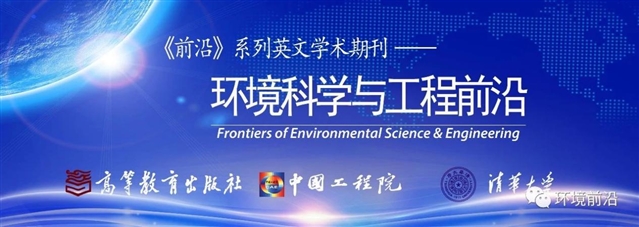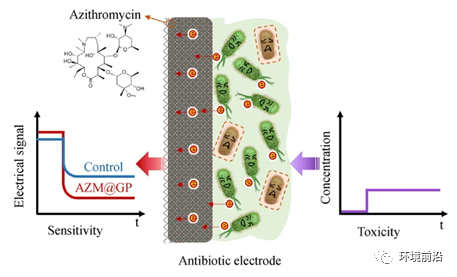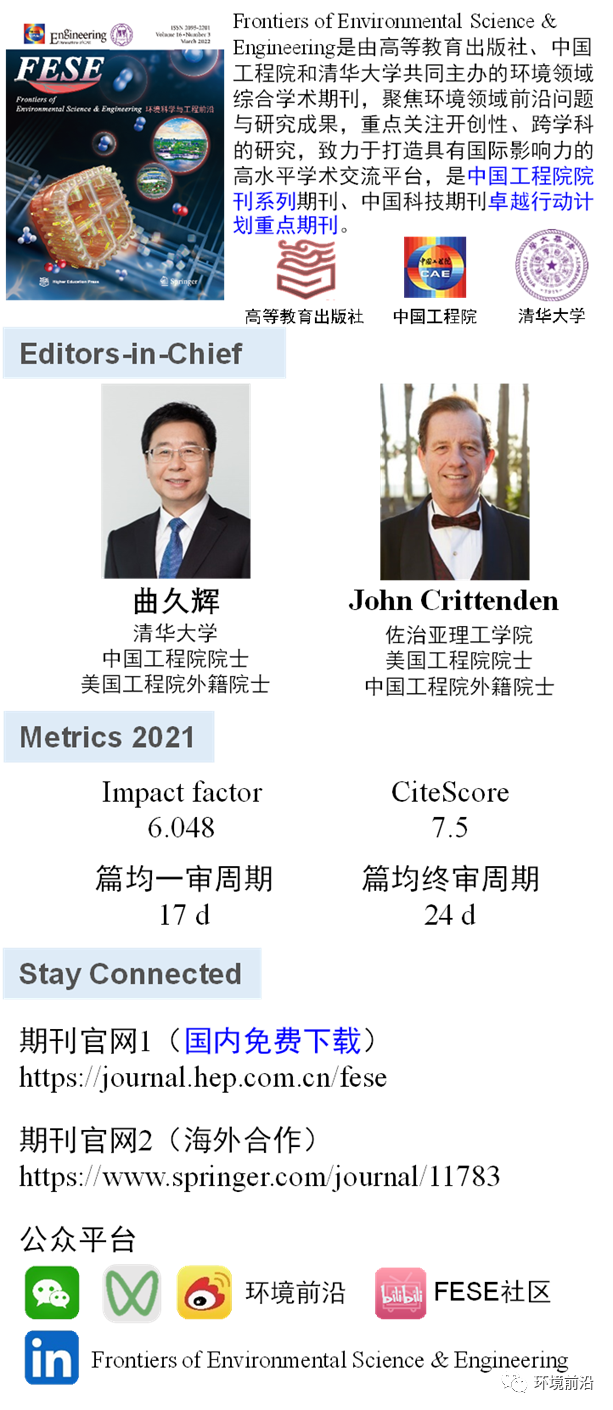|
|
| FESE | 封面报道:抗生素/石墨复合电极提升电化学活性生物膜传感器灵敏度 |
|
论文标题:An antibiotic composite electrode for improving the sensitivity of electrochemically active biofilm biosensor(封面报道:抗生素/石墨复合电极提升电化学活性生物膜传感器灵敏度)
期刊:Frontiers of Environmental Science & Engineering
作者:Shuyi Wang, Xiang Qi, Yong Jiang, Panpan Liu, Wen Hao, Jinbin Han, Peng Liang
发表时间:15 Aug 2022
DOI:10.1007/s11783-022-1518-7
微信链接:点击此处阅读微信文章

原文链接(点击“阅读原文”直接获取)
https://journal.hep.com.cn/fese/EN/10.1007/s11783-022-1518-7
文章出版:Front. Environ. Sci. Eng. 2022, 16(8): 97
原文信息
题目:
An antibiotic composite electrode for improving the sensitivity of electrochemically active biofilm biosensor
作者:
Shuyi Wang1, Xiang Qi1, Yong Jiang ( )2, Panpan Liu3, Wen Hao1, Jinbin Han1, Peng Liang (
)2, Panpan Liu3, Wen Hao1, Jinbin Han1, Peng Liang ( )1
)1
作者单位:
1 Tsinghua University, China
2 Fujian Agriculture and Forestry University, China
3 Zhengzhou University, China
通讯作者邮箱:
jiangyongchange@163.com
liangpeng@tsinghuaedu.cn
关键词:
AZM@GP composite electrode (阿奇霉素/石墨复合电极);
EAB-biosensor (电化学活性生物膜传感器);
Water quality early-warning (水质预警)
文章亮点
• 构建配备阿奇霉素/石墨复合电极的EAB生物传感器;
• 阿奇霉素0.5%剂量可提升传感器的灵敏度;
• 阿奇霉素提高地杆菌的相对丰度;
• 阿奇霉素削减电活性生物膜的厚度。
文章简介
水质监测是保障水生态环境安全的有效措施;生物传感器可表征水环境污染物的生物学效应。其中,电化学活性生物膜(EAB)传感器可自发产生电信号,受到了水质监测领域研究者的广泛研究。灵敏度是EAB生物传感器性能的一个主要指标。已有报道通过操作条件优化,装置设计,传质强化,EAB菌群结构调控等方式提高灵敏度。然而,这些方式均局限于特定研究情景,尚缺乏实际工程推广的可行性。针对水体连续流动的水质监测过程,本文使用特定剂量的阿奇霉素(AZM)抑制非电活性微生物生长,控制EAB厚度,改善电信号传递及物质传质过程,提高EAB生物传感器灵敏度。
本研究使用AZM和石墨粉(GP),构建新型复合电极,提高EAB生物传感器的灵敏度。主要结论如下:
(1)制备系列AZM@GP复合电极,发现0.5%的AZM剂量有利于提高EAB生物传感器的性能:启动时间从35天减少至27天,对甲醛毒性的灵敏度提升30%-65%。
(2)表征生物膜形态和微生物群落,发现灵敏度提升的原因是:EAB厚度削减;地杆菌丰度提高。

文章摘要图
编委点评
电化学活性生物膜传感器是一种维护简单、成本低廉的在线水质监测技术。实现电极生物膜的快速、标准化、可重复制备,保证传感器的可重复性和高灵敏度是推进该技术实用化的关键。本文制备了一种新型的抗生素/石墨复合电极,有效缩短传感器启动时间,提高灵敏度,揭示抗生素对电极生物膜形貌和菌群结构的影响,对相关研究具有一定参考价值。
编者 | 蔡佳仪
点评 | 蒋永
致 谢
蒋永,男,福建农林大学资源与环境学院副教授,FESE青年编委。主要从事微生物电化学技术。主持国家自然科学基金等项目,第一/通讯作者在Engineering,Water Research等杂志发表论文30余篇。课题组网页:http://teacher.fafu.edu.cn/zhcy/jy1/list.htm。
蔡佳仪,女,27岁,福建农林大学资源与环境学院2020级环境科学与工程专业硕士生,导师为蒋永副教授,研究方向为微生物电化学传感器。
摘要
Extensive research has been carried out for improved sensitivity of electroactive biofilm-based sensor (EAB-sensor), which is recognized as a useful tool in water quality early-warning. Antibiotic that is employed widely to treat infection has been proved feasible in this study to regulate the EAB and to increase the EAB-biosensor’s sensitivity. A novel composite electrode was prepared using azithromycin (AZM) and graphite powder (GP), namely AZM@GP electrode, and was employed as the anode in EAB-biosensor. Different dosages of AZM, i.e., 2 mg, 4 mg, and 8 mg, referred to as 0.25%, 0.5% and 1% AZM@GP were under examination. Results showed that EAB-biosensor was greatly benefited from appropriate dosage of AZM (0.5% AZM@GP) with reduced start-up time period, comparatively higher voltage output, more readable electrical signal and increased inhibition rate (30%-65% higher than control sensor with GP electrode) when exposing to toxic formaldehyde. This may be attributed to the fact that AZM inhibited the growth of non-EAM without much influence on the physiologic or metabolism activities of EAM under proper dosage. Further investigation of the biofilm morphology and microbial community analysis suggested that the biofilm formation was optimized with reduced thickness and enriched Geobacter with 0.5% AZM@GP dosage. This novel electrode is easily fabricated and equipped, and therefore would be a promising way to facilitate the practical application of EAB-sensors.
期刊简介

《前沿》系列英文学术期刊
由教育部主管、高等教育出版社主办的《前沿》(Frontiers)系列英文学术期刊,于2006年正式创刊,以网络版和印刷版向全球发行。系列期刊包括基础科学、 、工程技术和人文社会科学四个主题,是我国覆盖学科最广泛的英文学术期刊群,其中13种被SCI收录,其他也被A&HCI、Ei、MEDLINE或相应学科国际权威检索系统收录,具有一定的国际学术影响力。系列期刊采用在线优先出版方式,保证文章以最快速度发表。
中国学术前沿期刊网
http://journal.hep.com.cn

特别声明:本文转载仅仅是出于传播信息的需要,并不意味着代表本网站观点或证实其内容的真实性;如其他媒体、网站或个人从本网站转载使用,须保留本网站注明的“来源”,并自负版权等法律责任;作者如果不希望被转载或者联系转载稿费等事宜,请与我们接洽。